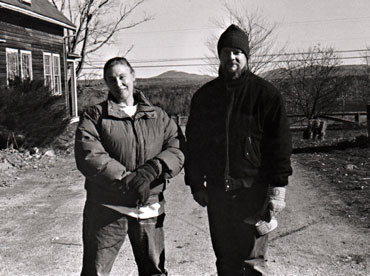 |
| Charlotte Young and Jim Baranski offer a diversity of crops and products at Shalom Orchard in Franklin, Maine. Jane Lamb photo. |
By Jane Lamb
Not many turkeys, organic or otherwise, can enjoy a 360-degree view of scenic Hancock County and beyond, from the Schoodic hills to the east, the Acadia mountains to the south, the Bangor hills to the west and, on a perfect day, perhaps a glimpse all the way to Mt. Katahdin to the north. On a bright, brisk, early November day last year, 25 or more Giant White birds at Shalom Orchard in Franklin ran eagerly to the fence to greet any possibility of food or friendship, as blissfully unaware of their upcoming fate as they undoubtedly were of the superb scenery.
Not so their growers, Charlotte Young and Jim Baranski. Finishing their flock for holiday sales is business as usual, but the beauty of the setting is a fresh, daily occasion for rejoicing. “We first came to look at the place in October,” Jim relates. “We got here just as the sun was setting. Everything – trees, grass, sky – was orange!”
“We got into town late,” Charlotte adds. “We didn’t have the realtor with us. We knew where it was and we wanted to see it before it got dark. We drove out and ran up to the orchard and the sunset. The realtor told us she couldn’t have planned it better. We really lucked out finding this place. It’s so beautiful.” They were hooked.
“And this high ridge also creates a favorable microclimate,” Jim points out. “The air drainage gives us about a month longer growing cycle, about two weeks earlier in spring and two weeks later in fall.”
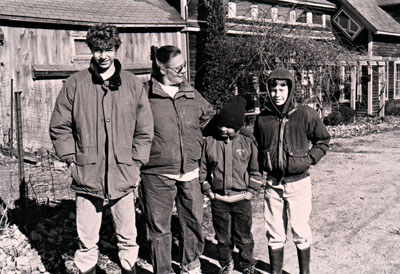 |
| From left to right, Ric, Charlotte, Chris and Jacob of Shalom Orchard. Chris hangs out with his two uncles, whom he thinks are his brothers, helping whenever he can. Charlotte calls them the Three Musketeers, although Jim affectionately says that the Three Stooges might be a better label. Jane Lamb photo. |
Having spent one unforgettable weekend on an island near Port Clyde, Jim and Charlotte decided Maine was where they wanted to live and raise Jim’s sons, Ric and Jacob. They were looking for a farm where they could grow fruit. Scenery aside, it was the established, 1,400-tree apple orchard that made the property in Franklin so attractive. Charlotte and her former husband (still a friend, who actually found Shalom Orchard, told them about it and settled elsewhere) had operated a commercial winery in Connecticut. “I had planted 12 acres of wine grapes and I knew I didn’t want to go through that again!” Charlotte declares.
The dwarf and semi-dwarf apple trees, MacIntosh and Wolf River, were planted between 1980 and 1992. The owners, who had operated the orchard conventionally, had moved away two-and-a-half years before the Young-Baranski team purchased the farm in 1994. Though the period of neglect made some reviving necessary, they had only a six-month wait before the orchard could be certified. “Of course, we didn’t have any apples to certify,” Charlotte notes. “The trees were in terrible shape.” Restoration began at once.
The Challenge of Organic Apples
“Probably the frontier [of organic apple-growing] right now is in the Northeast,” says Jim. “It’s incredibly challenging. We’re still very much at the beginning of our learning curve.” They have begun to tackle the biggest problems – scab, plum curculio and apple maggot. “But there are an awful lot of other things,” he says. Though they have planted some of the new, organic-friendly varieties, such as Liberty, the old favorites, MacIntosh and Wolf River, which comprise the original orchard, are neither disease-resistant nor expendable. “For scab, we spray copper sulfate in spring before the trees leaf out. There’s a complicated decision-making process for when you spray copper – how long the trees are wet after each rain, how many hours, what temperature. We’re constantly watching the weather.” They keep track of degree days with a recording thermometer and find themselves glued to weather patterns during the four- to six-week period before the leaves emerge. The scab risk is pretty much past by the middle of June.
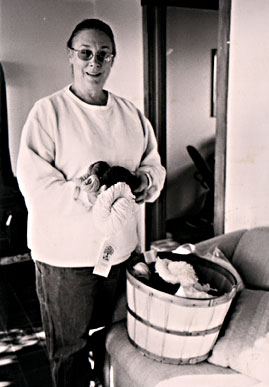 |
| Shalom Orchard yarn is one of the many value-added goods sold by Charlotte and Jim. Jane Lamb photo. |
For plum curculio, probably the worst plague of Northeastern apples, Jim and Charlotte are experimenting with a new product, now in its trial stage. The basic ingredient is kaolin clay. Sprayed on with a mixture of water and a spreader-sticker, it covers the trees with a powder that plugs the insects’ air vents and causes them to die. “It’s an absolutely safe insecticide,” says Charlotte. “Called Surround, it’s been registered in Oregon and Washington State. But [clay] is all it is, so lots of people in the Northeast just mix it up themselves. We’ve certainly seen a big difference in plum curculio damage. We think it dropped from about 50 to 60 percent down to about 15 percent, which is huge.” While the mixture is thought to be effective against some other insects as well, they haven’t tested that possibility yet. For apple maggot they use sticky balls only for monitoring, because the orchard is too big to use them for trapping the insect.
Blueberries, Another Challenge
Wild, organically-grown blueberries are the other major fruit in the Shalom Orchard operation. Jim and Charlotte lease 8 acres of blueberry land in Gouldsboro in addition to the 5 acres on the farm. “I’ve been managing them mostly by benign neglect,” Jim admits. Without the use of herbicides, weeds have become a serious problem. Flail mowing has had mixed results. Burning is another option. “I’ve been experimenting with mulching, but it hasn’t worked very well. Everything we try creates another set of problems,” Jim said last November. On the positive side, their blueberry land is quite low, so the water upon which wild blueberries are so dependent hasn’t been a problem. In addition to their own few hives of bees, they rent a dozen or more from a local friend to pollinate both blueberries and apples.
Whatever the perceived obstacles, nature has its own way of upsetting human predictions. This year’s blueberry harvest was “wonderful,” Charlotte reported in September. In addition to fresh-market and frozen bulk sales, they put 1000 pounds of blueberries in the freezer for wine-making. The small fruit harvest was bountiful as well – plentiful cherries and 40 to 50 pounds from each of six plum trees. The two-year-old raspberry patch is beginning to produce, promising a bumper crop next year. Jim and Charlotte belong to the Maine Organic Blueberry Growers Association and the Hancock County Growers Coop (as well as MOFGA). They market through those outlets, a few health food and alternative stores, direct sales at the farm to people who find them in The MOF&G list of certified growers, and occasionally to pick-your-own customers. Word of mouth is their only advertising and they have many repeat customers.
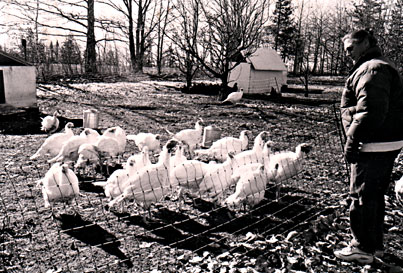 |
| Charlotte and the turkeys. Jane Lamb photo. |
Certified Organic Wines
The most exciting recent event at Shalom Orchard was raising the post and beam frame of the new winery building September 9, on the site of a former old shed connecting the house and barn. “There it stood in its naked, skeletal beauty with a hemlock tree nailed to the peak,” Charlotte exulted the next day, envisioning its significance as the heart of the farm’s entire operation, shortly to be enclosed within. Two stories with a full basement, the long-dreamed-of winery will house not only a commercial winemaking process and a blueberry-winnowing operation, but also a licensed production kitchen for Charlotte’s jams, applesauce and blueberry syrup and a space for her projected wool-dyeing as well as other farm activities as they evolve.
The couple’s goal is to produce certified organic fruit wines, as far as they know, the only such business in Maine. They expect to begin producing blueberry, apple and mixed-fruit wines this winter, making practical use of the non-farming season. The small apple crop this year, being too small to make commercial quantities of their usual cider, was saved for wine-making. They will begin selling young wines next summer. Unlike grape wines, other fruit wines don’t have to age, Charlotte explains. Later they hope to make a wine from Maréchal Foch grapes, which are known to thrive as far north as Aroostook County. “But we’ll have a local friend grow them,” Charlotte hastens to add, as determined as ever to have nothing to do with planting grapes.
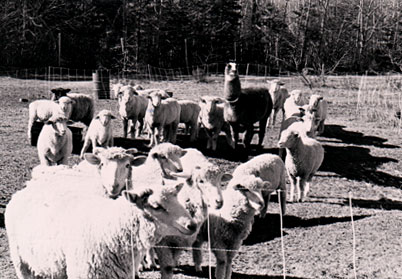 |
| Some of the Rambouillets who live at Shalom Orchard, and Shelly, the guard llama. Jane Lamb photo. |
About Those Turkeys
Jim and Charlotte raise 25 or 30 organic turkeys every year for special order. “We really like turkeys,” Charlotte says,” But they’re very hard to raise. You have to get day-old poults in order to raise them organically. The most important thing is the temperature. And you basically have to encourage them to eat and drink, put shiny things like marbles in their food and stick their little beaks in water.”
“A baby chick, typically, will have a brooder cage with a heat lamp in the center,” Jim says. “The chick will run under the light or over in the corner to find a comfortable spot. A turkey won’t do that. It will sit under the lamp and broil itself to death or pile into a corner and smother. You have to have several heat lamps and raise and lower the lights to keep an even temperature. We wish they were a little smarter. The first couple of weeks are critical. We keep them in [for] about two months until they’re feathered out. We usually start them in July for Thanksgiving.
“The interesting thing about our turkeys,” he continues, “is you go to a turkey farm and the turkeys are all puffed up like traditional pictures and go gobble gobble. Our turkeys don’t do that. One or two are puffing up, but I think our turkeys aren’t stressed as much as non-organic turkeys. I think it makes a difference in their behavior. These are organic and free range [within a large, fenced-in area].” Jim would like to try raising some wild turkeys, thinking they may be hardier.
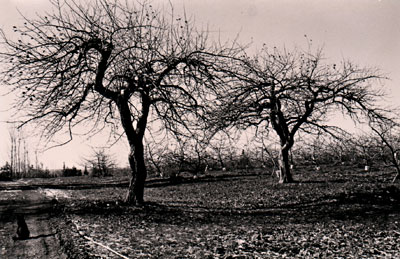 |
| Two old Wolf River apple trees grace the landscape. Jane Lamb photo. |
Lots More Chickens
While Jim and Charlotte raise just a few organic turkeys, their all-organic chicken flocks are sizeable – 800 meat birds and 500 layers. The bird of choice is the Australorp, a breed developed in Australia from Black Orpington stock. The meat birds are four to 4- to 4-1/2-pound roasters. The layers produce an average of 180 dozen eggs per week. After two years of heavy laying, some are sold to people who are more interested in organic eggs than top production. Many end up in the stew pot. “We decided to use a fairly heavy-weight bird so when they’re retired they can become nice, fat stewing fowl,” Charlotte says. “Some people know how different the flavor of a free-range fowl is. We’re trying to work out connections with local restaurants to sell them for stewing or stock or salad. We had a great soup the other night.”
The chickens “range” in large, moveable pens of electric poultry net fencing, each with its coop where they can spend the night. Certified layers arrive as day-old chicks and eat expensive organic grain for five or six months before they start to lay. Nevertheless, Charlotte and Jim opted this year to go to an entirely organic flock, after several years with half the number non-organic. Organic eggs wholesale at $3 per dozen, non-organic, free range at $2 a per dozen. They buy organic grain in bulk from Vermont, 3 tons at a time. They’re interested in the news that a Canadian grain company has just been given Maine certification, which might reduce transportation costs, the major deterrent for many farmers who would like to raise organic animals.
And Heaps of Sheep
Sheep are the only non-organically-certified animals on the farm, only because the organic grain they share with the other livestock is fortified with “brewer’s grain” from a Mt. Desert brewery. After the grain has been cooked and a lot of sugar taken out before it’s fermented, it has a high (20 percent) protein content. “We talked with Eric [Sideman] about it and we all feel it makes ecological sense to recycle this high quality grain [rather than dumping it],” Charlotte says.
“We use it as fertilizer and mulch, but we run it through the sheep first,” Jim remarks wryly. The sheep earn their keep in many ways. In the fall, Jim sets their flexible electric fencing between the orchard rows, where they mow the grass, clean up the drops and fertilize as they go. It beats shoveling and spreading manure, he reckons. Pomace from cider production is also recycled through the sheep and chickens.
“Sheep and chickens and small farms have always been a part of my life,” says Charlotte, who grew up in South Carolina and has been moving north ever since, losing all but a faint trace of her tell-tale accent. “When Jim and I set up our lives together, we had a few sheep and chickens on a mostly wooded property in Connecticut. When we moved up here, Jim got a U-Haul and moved five sheep, a dozen chickens, three dogs, two kids and a sailboat attached to the back. That’s what really started our sheep.” They now have more than 50 ewes, mostly Rambouillet, working toward a 100-percent Rambouillet, 100-head flock. They keep most of the females and sell the ram lambs for meat. The sheep are watched over by Shelly, a guard llama. “He’s nifty, a great guy,” says Charlotte. “He keeps coyotes, bears, everything away.”
The Rambouillet fleece becomes Shalom Orchard yarn. “Winter is the time for yarn,” Charlotte remarks. She joined the Wednesday Spinners in Ellsworth, where Suzanne Grosjean, a neighbor and veteran Wednesday Spinner, is her mentor. Charlotte does some spinning, “But I can’t do everything. I send a lot of fleece to Green Mountain Spinnery in Vermont. That’s now a certified organic facility, both the wool and the method they use. They will use non-organic fleece, but don’t use any petrochemicals,” she explains. “I’m just doing sport weight so far, because Rambouillet lends itself to very fine, stretchy yarn. It’s beautiful in cable patterns, wonderful for children’s sweaters because it doesn’t itch. It almost feels like cotton when it’s finished.”
She brings out an array of yarn samples in natural gray, white and brown, and warm, earthy, natural dye tones produced by indigo, madder and osage. “I’m having some yarns dyed in Massachusetts at a place called Shades. She uses only plant extracts with alum as mordant, so all of my yarns are completely non-toxic, all natural and color-fast.” Charlotte is looking forward to experimenting with plant dyes in her new work room.
And They Both Have Day Jobs!
Jim grew up in northern Michigan on Lake St. Clair, “the smallest Great Lake,” he insists, in the face of Charlotte’s good-natured skepticism. He attended Michigan Technological University, originally the Michigan College of Mines, in a once-flourishing mining area. He came east to work for Digital Equipment in Boston and moved to Connecticut when he met Charlotte. Ric and Jacob came to live with them full time when their mother was killed in a car accident in Michigan. “They were only seven and nine at the time,” Jim says. “That made us look at our lives and say we didn’t want to live like this, both working about 60 hours a week. We didn’t want them in day care after school. I was working for a Navy sonar research lab in New London which was closing down. There were a lot of reasons for us to move. It took us two years to do it.” Jim found a job at the Jackson Laboratory in Bar Harbor where he’s a computer programmer.
Charlotte is a licensed marriage and family counselor. She earned a masters degree at the University of Rhode Island and practices three days a week in her Ellsworth office, which she moved from the farm when construction on the new building began. She’s also a guardian ad litum and is on the faculty of the Family Institute of Maine, so she teaches as well. “Fortunately a lot of my clients are families with children, referred by schools, so during the summer when the farm is busiest, the case load shrinks.” She does what Jim calls “farm therapy.” “I haven’t made them work yet, but I take all my kids out to meet the animals. There’ve been some pretty interesting situations. I usually take time out during lambing. I was out in the barn delivering a lamb and a client was waiting. I apologized for being late and she said, ‘Let me come out and help.’ It turned out to be an incredibly therapeutic experience for her. Sometimes the farm offers a lot in ways you would never expect.”
Jim and Charlotte were delighted when the science teacher at Mountain View Middle School asked to bring his class out to do a project on IPM management in organic apple growing. “We really are interested in the farm becoming an educational opportunity for kids,” Charlotte says. “We’re so amazed every year at how few of our kids’ friends know anything abut farms. In this rural community I thought they would at least have a grandparent who had a farm. But they seem to be very removed from it. They also love to come here and work. Our sons can’t quite understand that!”
Actually, Ric, 15 and Jacob, 13, take great pride in their importance on the Shalom Orchard work force. Ric is chief shepherd, and red-headed Jacob is chief poultryman. Two or three local folks work part time on the farm when needed, and area teenagers are full-time blueberry rakers in season. Charlotte’s daughter and son-in-law, Kendall and Steve Penado, and their children, Kamaria, 3, and Christopher, 8, will soon be installed on their adjoining farm, Capricorn Acres. They plan to raise meat goats, in the tradition of Steve’s Jamaican heritage. Charlotte’s son, a recent graduate of the Culinary Institute of America, is a chef who lives in Connecticut.
Peace with Nature
An Episcopal minister who owned the place in the l950s and ’60s named it Shalom Farm and had a painting on the barn of a rainbow and doves, Charlotte relates. “We’ve seen pictures of it, a very sixties kind of painting. He had foster children and farmed here with them. Owners in between named it something else. When we first looked at it neighbors told us it used to be called Shalom. We decided that was perfect, exactly our philosophy here, to work with nature rather than try to force nature to bend with chemicals. We try to work in peace with nature.” Shalom Orchard’s logo is a sturdy apple tree sheltering a contented quintet of animals (but oddly enough, not one of those laid-back turkeys). Underneath is the farm’s motto, “Peace with Nature.”
About the author: Jane Lamb wrote feature stories for The MOF&G for many years.
